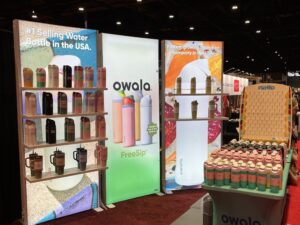Recently updated on June 10th, 2025
One of the most important choices you will have to make when organizing a trade show or event is choosing outdoor vs indoor vendor booth displays. Every choice has specific advantages and disadvantages that may affect your performance, audience engagement, and visibility. Making an informed choice will be aided by knowing the particular requirements of your event, the kind of audience you’re aiming for, and the associated logistics. Whether you’re displaying high-tech equipment in a controlled indoor setting or major products outdoors, choosing the right option may boost your brand and make attendees’ experiences unforgettable.
Difference Between Outdoor Vs Indoor Displays At Trade Shows
The sort of audience, setup logistics, and overall experience are all impacted by the notable differences between outdoor and indoor displays at trade shows. Here’s a comparison of outdoor vs indoor displays for trade shows:
Cost Considerations
Outdoor trade show booths can be more expensive because of the added cost of weather-resistant materials, protective coverings, and renting outdoor space. But overall costs might still be less than renting in-house space, depending on the event.
Indoor trade shows tend to be more expensive in terms of booth rentals, particularly in popular locations. Exhibitors may also have to pay for electricity, Wi-Hi-Fi, or special display arrangements. Although indoor venues are generally more costly, the climate-controlled setting can make up for the expense by offering a more stable and comfortable experience.
Durability And Maintenance
Since they are exposed to extreme weather, outdoor stands would likely need more maintenance. The exhibitors should always be vigilant about weather wear and tears and expect unexpected weather changes (such as storms or excessive sunlight).
Booths’ indoor areas are less susceptible to wear and tear and degradation by nature because they are shielded from the elements. Hence, exhibitors generally find it easier to maintain their exhibits in great condition, and the overall installation is more durable.
Flexible Space And Layout
Larger installations can usually find more room and flexibility at outdoor trade shows. You can construct enormous booths, add interactive features, or include bigger attractions like machinery, cars, or product demonstrations. A more powerful impact can be achieved by using this area imaginatively.
Because indoor trade shows typically have less room, exhibitors may need to arrange their displays more strategically and effectively. Even though they might not have as much space as outdoor events, indoor venues offer better control over visitor flow and more defined areas. Booth designs can incorporate more personal product demonstrations, smaller interactive displays, and complex tech sets.
Setup And Logistics
It will be harder to install an outdoor exhibit due to the need of sturdy, weather-resistant structures and materials. Exhibitors may need to purchase tents, canopies, weighted frames, or even flooring to secure the installation. In addition, shipping heavy or bulky items might be required.
Interior installations are easier to manage due to the controlled environment. Elimination of weather conditions allows more sophisticated installations that involve technology, lighting, and interactivity. The structure itself usually provides basic amenities like electricity, security, and equipment.
Technology And Equipment
Outdoor use of technology can be challenging due to sun exposure, water, and temperature. Any piece of electronic equipment, whether screens or an interactive kiosk, must be weatherproof or under a canopy. You will also require alternative power sources and backup systems.
Indoor arrangements allow the use of advanced technology without fear of weather. Exhibitors can easily incorporate digital displays, virtual reality booths, touch-enabled screens, and ambiance lighting. Indoor booths are likely to have consistent power and internet services, which allow the incorporation of technology more easily.
Visibility And Audience Engagement
High visibility is advantageous for outdoor displays, particularly when placed in busy locations such as outdoor trade shows, festivals, or sporting events. Larger, bolder designs are possible in the open area, which can make them more striking. People who are passing by and don’t have any plans to attend the show might be drawn to your exhibit, which could allow you to engage with a wider audience.
Since visitors typically choose to attend events, indoor displays typically appeal to a more niche demographic. The benefit of the display is that it is situated in a restricted, concentrated area where customers are typically more likely to interact with your goods or services. A more personal, in-depth presentation of your products is possible indoors.
Weather And Environment
Displays at outdoor trade shows are subject to weather circumstances like rain, sun, wind, and temperature changes. Because of this, displays need to be constructed using materials that can withstand weather and be built to last. Weather unpredictability might affect the display’s stability, setup, and even safety.
Trade shows that indoors in controlled environments are unaffected by the weather. A more predictable setup and experience are made possible by the constant display conditions (lighting, temperature, etc.) and the fact that exhibitors are not affected by wind or rain.

Tips On How To Choose Outdoor Vs Indoor Displays
Consider the type of event when choosing between outdoor vs indoor displays, as each location has its benefits based on the event mood and crowd.
· Go for outdoor instructions when you want to reach a larger audience in outdoor settings, like festivals or big expos, where visibility is paramount.
· If your business or service requires larger installations, such as vehicles or equipment, outdoor displays can offer more room for extensive installations.
· Assess the climate, if your event is exposed to possible rain, wind, or intense heat, outdoor displays might need extra measures and weatherproofing.
· Indoor displays are best suited for more specific, business-oriented audiences, such as at conventions or conferences, where guests specifically attend to interact with industry experts.
· If your display incorporates sophisticated technology, indoor spaces are more capable of accommodating technology-based displays such as screens, touchpads, or interactive installations without issues caused by the weather.
· Costs of booth space—while outdoor displays might be cheaper in regard to renting space, indoor displays might cost more but provide a contained environment that can simplify logistics.
· For long events, where your screen will be out for many days, indoor displays are more stable and less exposed to the elements, maintaining your materials and technology intact.
· Consider how visibility matters for your display—outdoor displays catch the eye of those walking by because they’re exposed to pedestrian traffic, whereas indoor displays can provide a more concentrated, personal audience.
· Choosing based on configuration and logistics—outdoor displays may be more difficult to install, involving more equipment and time, while indoor configurations tend to be less complicated and with more assistance offered by the event organizers.
Conclusion
Outdoor vs indoor displays each have their strengths and weaknesses in trade show environments. Outdoor displays excel for high visibility, large-scale installations, and attracting a wider audience, but involve the requirement for weather-resistant materials and more complex logistics. Indoor displays offer an inside environment with less complex logistics, improved technological integration, and a focused audience. The decision between outdoor vs indoor displays will mostly depend on your objectives, type of product, target audience, and the character of the trade show.



